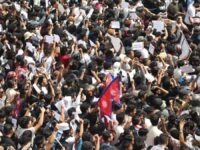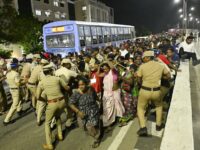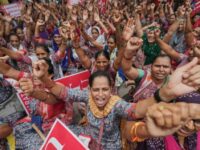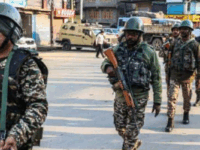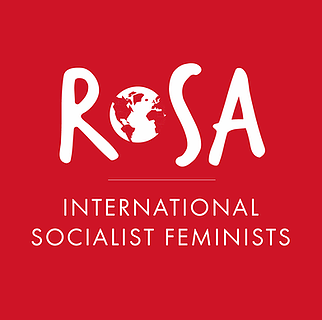Israel-Palestine. Amid Normalization of Occupation and Siege, New War Erupts
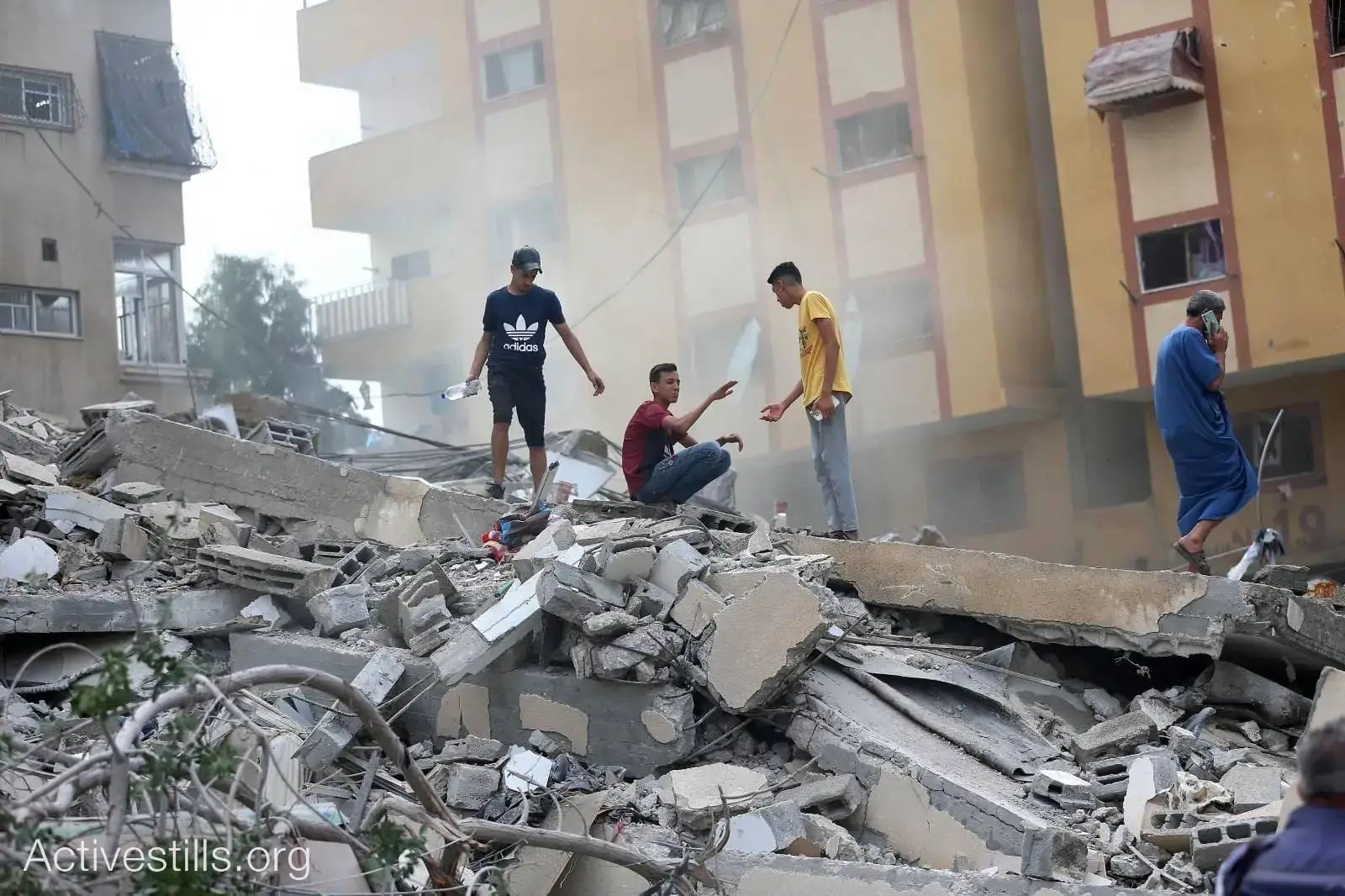
The dramatic actions of warfare this weekend — with over one thousand dead so far — in Israel and the Gaza Strip has shaken the world. This could be the beginning of further instability and expanded war. Here is a first translated statement from the Secretariat of Socialist Struggle (ISA in Israel-Palestine) published originally in Hebrew on Sunday 8 October.
In face of loss and bloodbath, struggle for a root solution is needed
Solidarity with those who have lost their loved ones and with ordinary men and women from all communities, on both sides of the fence, who face the horrors of war ⬤ At the heart of the ‘failure’: the arrogance of the government’s “conflict management” policy and the normalization of the occupation and siege led to war ⬤ What’s needed is a struggle to stop the deterioration and to end the siege, occupation and poverty, as part of a struggle for a root solution to the endless rounds of conflict, within the framework of socialist change, on the basis of guaranteeing equal rights to existence, self-determination, dignity and well-being
The war crisis that erupted on Saturday morning, with a surprise attack by Hamas which was unprecedented in its scope (“Operation Al-Aqsa Flood”), that has continued with an attack that is expected to be even more bloody from the Netanyahu government (which declared an official state of war), continues to produce horrific events among communities on both sides of the fence. This is on a scale that is only getting worse for residents of the Gaza Strip, under the Israeli-Egyptian siege, where Netanyahu promised “revenge” that would turn “the city of evil into a city of rubble”.
At the same time, the death toll resulting from the massacre that took place among hundreds of residents in the towns and communities in the south of the country, and from indiscriminate rocket fire, is increasing, including among Bedouin communities where to begin with there are no shelters. In the meantime, the military escalation has spread to the Israel-Lebanon border, with rocket fire from Hezbollah, which appears to be a warning message against a possible Israeli invasion of Gaza. The crisis may continue to develop for weeks and even deteriorate into a regional war.
Shock, grief and fear now prevail among the residents of the Negev area and other districts, and not only among the Jewish population, and in the Gaza Strip even more so, amidst the bombings, of course without any parallel to an ‘Iron Dome’ system, or sirens or shelters. The Socialist Struggle Movement (ISA in Israel-Palestine) stands in solidarity with ordinary people, with the relatives of those killed and with the wounded from all communities, on both sides of the fence, and with the abducted civilians. At the time of writing these lines, the reported number of killed has risen above 700 in the South, from various national communities, and 500 in the Gaza Strip (Monday figures). All this while the Netanyahu government is promoting brutal collective punishment, including cutting off electricity and reducing buildings to rubble in Gaza: in fact, a means of state terrorism.
The abduction, on an unprecedented scale, of dozens of Israeli men and women to the Gaza Strip, was intended on the part of Hamas to restrain the Israeli regime’s firepower response and to serve as a means of bargaining for the release of Palestinian prisoners. The abduction of the civilians, including children and elderly women, deserves condemnation — it is not them who are the responsible for the brutal policies of the Israeli regime in the Gaza Strip and towards the Palestinians. It is important to mention that these policies, which include mass incarceration, with a military trial or without any trial, not least of children and of Palestinian residents seeking to demonstrate and oppose military occupation, are also what fueled the motivation for abductions in the first place. Now, a military intervention in an attempt to free the hostages would involve a large number of deaths. The Israeli government should be demanded to allow a quick and comprehensive prisoner deal within the framework of a ceasefire arrangement.
We call for protests to stop the war and policies of collective punishment and “divide and rule”, to refuse to take part in a revenge offensive against the residents of Gaza, and to fight for a profound change in the reality of life, including the end of the occupation and siege. Also, the calls for a protest strike and marches of rage in the West Bank may help build a necessary struggle to challenge the status quo — the dictatorship of occupation and siege — while preparing for self-defense and protection of the Palestinian marchers and residents.
The military escalation in the national conflict did not come from nowhere. The so-called fully right-wing government led by Netanyahu, Ben Gvir and Smotrich operated with full vigor not only to deny the mass opposition to the “judicial coup” plan that was designed to strengthen its hand, but also to entrench the occupation and siege and the settlements imposed on millions of Palestinians. This, in the shadow of an arrogant claim to have “conflict management” under control and a cynical claim to supposedly promote regional peace through the normalization process between Israel and Saudi Arabia under the auspices of the US.
The acute and widespread war crisis that has now unfolded came after two rounds of military escalation since the formation (in December) of the government and following years when the frequency of rounds of conflict increased as an expression of the deepening instability of the occupation and siege. The current escalation includes exceptional features that mark a new phase of collision.
Surprise attack by Hamas
Hamas, which Israeli capitalist occupation governments to this day have claimed to “deter” (only recently Israel’s National Security Advisor, Tzachi Hanegbi, stated that “Hamas is very, very restrained”) temporarily breached the borders of the military blockade with forces of many hundreds of armed men, some even by sea and with paragliders. These forces took over the Erez/Beit Hanoun crossing and the headquarters of the Israeli army’s Gaza Division, confiscated military vehicles, and barricaded themselves in a police station in the southern town of Sderot. Additionally, alongside elements of partisan warfare against military forces, they took over a number of Israeli communities for long hours (up to over a day) and in the meantime, they also resorted to terror acts of indiscriminate killings of civilians, including music festival participants, and the aforementioned abduction of dozens of civilians.
Within hours, Hamas achieved its political goals, when beyond a show of force, it managed to add a complicating factor for the “normalization” between Israel and the Saudi regime, and for the Palestinian Authority. Although this is not the first raid by the military wing of Hamas over the Gaza Strip fence, it is the largest show of military force that Hamas has carried out so far, with an unprecedented level of skill and boldness, which were also wrapped in rhetoric framing the operation as a measure of liberation.
In the first hours, quite a few residents of the Strip took advantage of the temporary break of the siege to cross the fence and walk, if only for a moment, outside the largest prison camp in the world, with a sense of exaltation. For a mass of residents in Gaza and for many Palestinians in general, the possibility of witnessing, even for a moment, a breach of the siege fence and a show of force against the power that imprisons them, tramples on their lives and denies them national independence and any possibility of accessing the territory from which their family came, may in itself arouse sympathy towards the Hamas armed wing, portrayed in this context as a “protective force”.
On the other hand, the Israeli regime may cynically take advantage of the massive harm to Israeli civilians to foster the myth that the blockade of the Strip is a “defensive” policy and mobilize even more support for killing and destruction on a large scale in the Strip. The two million residents of the Gaza Strip live in conditions of extreme poverty and distress, with 63% suffering from food insecurity, without clean water, basic infrastructure and without freedom of movement. The Israeli regime politically exploits existential and security concerns among the Jewish working class to promote, among other things, oppression and attacks on Palestinians. At the same time, the daily attacks, as well as the devastation and bereavement left by Israeli bombings over the years, created in the first place the political possibility for Hamas to harness a mood of desperate support from parts of the Palestinian population, even for reactionary actions of indiscriminate attacks against civilian population.
Also, since the bloody balance between Israeli and Palestinian casualties is often one of extreme asymmetry — with dozens of Palestinian deaths for every Israeli death — the rare moments in which a somewhat more “equal” numerical balance is depicted, may in themselves strengthen desperate support for Hamas. It can pose as having an ability to “charge a price”, to take revenge, or even to build deterrence, or a military force that can defeat the occupation and siege.
The Hamas leadership knows that it is certainly not capable of militarily defeating the strongest military power in the region. Over the years, as is typical of a political force with a right-wing, pro-capitalist program — that implements political repression, attacks on Gazan workers and the poor, oppression of women and LGBTQ people and religious coercion — Hamas leaders relied on their dependence on the mercy of regimes in the region and imperialist powers, and even on “coexistence” arrangements with Israel. However, Hamas aims to produce a perception of victory through a military challenge — in contrast to the Palestinian Authority and the Arab regimes — in a pattern that resembles Hezbollah, which in 2006 showed from its side the limits of Israel’s regional power, and threatened in the past to take over Israeli communities as Hamas has now done.
Threats of a “decisive military resolution”
The Netanyahu government, which claimed to have proven its ability to completely dictate the agenda in the national conflict and “deter” any resistance, has now been exposed with a dramatic (albeit partial) loss of control over events, and is trying to regain the initiative through military means. It threatens a prolonged and far-reaching offensive on the Strip — fundamentally, to protect the existing order of occupation and siege that gave rise to the current crisis in the first place.
Defense Minister Galant threatens to “break Hamas’s neck”. This, in fact, was similar to Netanyahu’s threat back in the 2009 election campaign to inflict a so-called “decisive military resolution”. Even before that, Israeli governments assassinated Hamas leaders and attacked its forces. However, between rounds of bloodshed and the “restoration of deterrence”, the relative military capacity of Hamas, although limited, has increased and developed to the extent that the Israeli regime has been forced to take it more into account, while relying by default on “understandings” with the Hamas government in the Gaza Strip in order to preserve and maintain the existing order. An attempt by the Israeli regime to “defeat Hamas militarily” will not only be unable to eliminate the Hamas movement, but will also result in destabilizing consequences on a large scale, and that is why the Netanyahu government’s talking points use more vague terms.
The mobilization of the Israeli establishment parties from the slavish “opposition” to politically support the policies and military operations led by the Netanyahu-Ben Gvir gang in the current crisis, emphasizes their own responsibility, including during the previous government, for the current situation. Lapid’s and Gantz’s proposals to re-enter the government with Netanyahu under the auspices of the war crisis — with Lapid asking to replace far-right ministers, while Gantz is ready to keep them — prove by themselves that at the end of the day, the differences between the parties on core issues are narrow.
Netanyahu, whose government until the current crisis relied on the support of a distinct minority of the Israeli public, jumped at the opportunity to promote a broad coalition deal with the parties of Lapid and Gantz, without breaking from the far-right parties. This corresponds to the interest of the ruling class to try to limit an “adventurous” influence on the part of the far-right ministers in response to the events, and is also consistent with the pressures of the last period from Washington, in order to facilitate a normalization deal with the Saudi regime. However, Netanyahu is afraid of getting rid of Ben Gvir and Smotrich, since he competes with them over a base of support.
The fundamental cause of the war
The question “who fired the first shot” in the dynamics that led to the current crisis may provoke different answers considering the precedingly developing escalation in national tensions, but in any case it misses out the fundamental causes of war. Also the question of the “intelligence failure” of the Israeli army, 50 years since the 1973 war, distracts from the main point: the root of the crisis is the enforcement of the existing order in which Israeli capitalism, with the strongest military power in the region, imposes occupation and annexation and denies basic rights, including the right to self-determination, from millions of Palestinains.
The political support from capitalist governments from the “Western” imperialist bloc for the military actions of the Netanyahu government now provides leeway for the continuation of the bloodbath and illustrates a fundamental defense of the status quo of the occupation. The personal security of ordinary people on both sides of the fence is not only of no interest to them, but is harmed because of them.
Already, since the time of the previous Bennet-Lapid government, the number of Palestinian deaths has been on a sharp escalation trend and broke a 20-year record in the West Bank. Palestinian homes in the West Bank were destroyed at an accelerated rate; Attacks by the state and settlers aimed at uprooting Palestinian communities continued, along with an increase in religious-nationalist provocations by Jewish right-wing elements promoting a religious war with state sponsorship around Al-Aqsa Mosque. Economic crisis intensified the pressure cooker of life under the occupation. However, the Netanyahu-Ben Gvir government has led an even more intransigent line against any concessions to the Palestinians and sought to bury any idea of Palestinian independence.
Simultaneously, with the development of popular protest actions and armed confrontations, the leaderships of Hamas and the Palestinian Islamic Jihad (PIJ), under the auspices of Hezbollah and Iran, worked to portray themselves as more effective in the confrontation against the occupation compared to Fatah and the Palestinian Authority — which is in an acute crisis of legitimacy due to its de facto role as a subcontractor of the occupation. In the face of Netanyahu’s new government, Hamas and the PIJ announced this year that they would act as a single front in the confrontation with Israel, even though the Hamas leadership preferred not to enter into a direct conflict with Israel in the May flare up in the Gaza Strip and the July raids in the West Bank. However, two weeks ago, on 24 September, the leaders of Hamas, PIJ and the PFLP announced at a meeting in Beirut that they would increase coordination between them in order to escalate actions in response to the aggression of the occupation regime.
The crisis in the Strip and the protests on the fence
This announcement came in the midst of a new series of Palestinian protests on the Gaza fence, which were met with military repression. The Israeli regime feared that the protests would get out of control. A development in the direction of a mass struggle poses a more fundamental risk for the regime than rounds of military confrontation, not least considering the increased potential of a mass movement to evoke echoes and sympathy on a regional and global level, and even to influence workers and young people in the Jewish population. But in general, the Israeli regime feared destabilization and the development of confrontations in various arenas, which would put pressure on Riyadh against a normalization deal.
Such fear of destabilization has also, time and time again in recent months, led the heads of the military-security establishment, in coordination with Netanyahu and Gallant, to intervene to restrain the wing of the far-right, in particular with Ben Gvir’s attempts to advance attacks on the conditions of Palestinian prisoners. On 29 September it was reported in the Lebanese newspaper Al-Akhbar that the Israeli government, with Egyptian-Qatari mediation, apparently agreed to a “return to previous understandings”, to a renewed symbolic increase in Qatari aid funds to Gaza, as well as the quota of workers from the Gaza Strip entering Israel, the expansion of the fishing area at the shore of Gaza, and export and import quotas. Apparently, Israeli military forces were then diverted from the Gaza Strip area to the West Bank, which then facilitated the element of military surprise by Hamas.
While the Fatah-led Palestinian Authority has signaled a willingness to cooperate with Israeli-Saudi normalization, Saudi Crown Prince Bin Salman has signaled that as long as nothing stands in his way, the terms of Israeli concessions to the Palestinians will not be deal breakers. This insinuation, together with the deepening crisis in the Gaza Strip, despite the apparent understandings, apparently tipped the scales for the Hamas leadership to intervene militarily on an unprecedented scale in an effort to increase pressure on Israel by “changing the equation”. This was designed to demonstrate an ability to charge a higher price through military means, including disruption of the normalization process, and in the process create a false political impression of a step forward in the struggle to overcome the siege and occupation.
Building a struggle and advancing a way out
It is important to emphasize that in the face of a siege and occupation and of a possible military invasion, residents have the right to fight against attacks unleashed upon them and organize to defend themselves, including through partisan warfare. Many Palestinians must have been happy to see the symbolic destruction of a number of Israeli military vehicles, considering the destruction and bereavement and distress they have faced for years in the Gaza Strip. But there is a difference between such resistance — which can develop in the most beneficial way when it is part of a strategy of building a mass struggle that is needed now, and under the democratic control of elected action committees (which is not compatible with the political program and strategy of Hamas) — and the indiscriminate shooting and harming of the civilian population, in particular working and poor women and men from any national community. Hamas’s military attacks against workers and the poor not only do not promote liberation from blockade and national oppression, but are politically used as an excuse for the Israeli establishment to mobilize support for even more barbaric attacks against Palestinians under siege and occupation.
“National Security” Minister Ben Gvir declared a “state of emergency in the homefront”, which expands the powers of the police in the public sphere. This may also be used to increase political persecution in general, and against Arab-Palestinian activists in particular. In the background, there are reports of far-right activists looking to take advantage of the crisis to further inflame the national schism and promote attacks against the Arab-Palestinian community. It is necessary to organize a cross-community struggle against the attempts of the far-right to promote racist attacks and nationalistic clashes in the streets of cities, and against the government that nurtures these elements routinely and gives them increased political confidence through all of its policies.
The fact that the Netanyahu government has faced up until the present crisis a mass movement implies the potential, later on, also for the development of a wide protest response with criticisms over failures and responsibility for this war. However, the pro-establishment leadership of the mass movement — a self-appointed leadership which acts in the service of capitalists and generals who cynically leech on the the mass struggle against the “judicial coup” — has aligned itself with the official “opposition” parties, with political support for the government and the bombing of the residents of Gaza, and called for a freeze of the demonstrations.
It is necessary to promote protests and struggle now in order to show the necessary direction to stop the bloodbath and to solve the problems that led to the war. Following the experience of the May 2021 events, acts of protest and struggle are now necessary — such as the Palestinian “dignity strike” at the time, cross-community solidarity demonstrations at workplaces and schools, protest pickets, meetings of unions to take a stand — against the military escalation, against the bombings in Gaza, against the “divide and rule”, and against the continuation of the siege and occupation. Given the set of policies of national oppression, war crimes and inequality promoted by capitalist right-wing governments, it is necessary to place on the agenda the horizon of a way out, for the solution of the root problems, in the context of a struggle for socialist change in the region, on the basis of guaranteeing equal rights to existence, to self-determination and to life of dignity and well-being.

